Former Captain Gives Evidence on Conflict with Vietnam at Sea
Today, witness Prum Sarat concluded his testimony. He gave evidence on instructions given by the division as well as the chain of command. At the end of the sessions, new witness Min Yoeun was introduced to the Chamber.
Cadres
At the beginning of the session, the Trial Chamber Greffier confirmed the presence of all parties with Nuon Chea following the hearing from the holding cell. Witness 2-TCW-849 was on the reserve.
Senior Assistant Prosecutor Vincent de Wilde inquired about Khieu Samphan. Mr. Prum Sarat said that he worked with him in 1991. When Mr. de Wilde asked whether he was a direct subordinate of Khieu Samphan, Khieu Samphan Defense Counsel Anta Guissé objected, saying that the question lay outside the scope of the trial. The objection was overruled and Mr. de Wilde repeated his question. “I was part of the security team” that worked for Khieu Samphan.
He had said that Khieu Samphan was known to be “tricky” but that he was nice.[1]
Mr. Sarat replied that he did not use this term. Mr. de Wilde then wanted to know whether he worked with Hiengrit in Division 164. Mr. Sarat replied that they used to work in the same unit. He had told DC-Cam the address of this person. Mr. de Wilde asked whether he continued being close friends with him and whether they discussed the events of Democratic Kampuchea later. He denied both, saying that he was not close friends with Hiengrit, since this meant that one would day for one another. Mr. Koppe interjected and said that it seemed like the Prosecution was referring to Hiengrit’s DC-Cam statement, an interview that had not been translated into English. Mr. de Wilde replied that he referred to a part of Mr. Sarat’s interview, in which he mentioned Hiengrit.
Mr. Sarat did not know whether Hiengrit committed a mistake before being sent away. They were working at different locations. He was stationed on a vessel and not onshore.
Mr. de Wilde asked whether there were still many soldiers who came from the East Zone in Division 164. He replied that in early 1978, the remaining forces were removed from the ship and places on the shore to the headquarter.
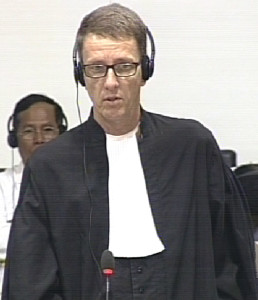
International Nuon Chea Defense Counsel Victor Koppe
Mr. de Wilde requested leave to present a list of trainees that attended a training session to the witness, which was granted.[2] Mr. de Wilde pointed to number 158, which read Commander Kim Nhann. He asked whether this was the same Nhann that he had referred to yesterday, which the witness confirmed. Mr. de Wilde then showed number 203, which showed Prum Sarat. The witness confirmed that this was indeed him. Mr. de Wilde asked why he was still called company chief in 1976, since he had finished his training to be vessel leader. He said that he had nothing to do with the division membership or committee. He was leading 110 members.
He said that he attended the study sessions led by Son Sen twice, one in late 1975 an another one later. He could not remember whether this took place in November 1976, as suggested by Mr. de Wilde. There was a discussion about the date with Ms. Guissé and Nuon Chea Defense Counsel Victor Koppe. The witness said that he received information about activities conducted by Sao Phim through the upper level. Mr. de Wilde wanted to know whether he ever heard the expression “hereditary enemy” as referred to for the Vietnamese. The witness said that he heard it since he was a child, even his grandfather used it.
Mr. de Wilde requested leave to present the Written Record of Interview of 2-TCW-1000 to the witness, which was granted.[3] He asked whether Mr. Sarat knew this person. The witness said that he does not know this person.
The Vietnamese as the hereditary enemy
This witness had said that the Vietnamese were all considered hereditary enemy without any distinction.[4] The witness replied that this term “had something to do with Cambodian tradition. And I myself understood the situation of the enemies, namely Yuon.” The same witness’s had said that the hereditary enemy was to be killed, even including the babies.[5] Mr. de Wilde asked whether he heard the regiment chief of battalion chief say that the Vietnamese had to be killed, because they were the hereditary enemy. He said that “he used to make that point very clearly. However, as I said, I had no responsibility concerning the tasks that were described in that document.” He confirmed that they had to be vigilant.
Mr. de Wilde then inquired whether he heard any broadcasts of Vietnamese confessions. He replied that he could not recall when this broadcast was made available, but confessions of Vietnamese people, and in particular of Vietnamese soldiers, were broadcasted.
When Mr. de Wilde attempted to use document 1249, which was a confessions broadcasted on the radio, Ms. Guissé objected and said that it might be unlawful to use this document. Mr. de Wilde said that he was not using the content to assert its truthfulness, nor was it clear whether this was the actual confession from S-21. There was a discussion between Mr. de Wilde and Ms. Guissé about the lawfulness of using such a document. The bench conferred on the issue. The President Nil Nonn announced that the objection was appropriate and the content of the confession could not be used.
Mr. de Wilde inquired whether the Vietnamese who were arrested at sea were already been sent to S-21 in 1977 already before Vietnam retracted from Cambodia in 1978. The witness said that he learned this information about the broadcast.
Mr.de Wilde asked whether he heard from his superiors that Vietnamese spies put children on the boat to hide amongst refugees. He replied that this was beyond his task that he had to perform and that he did not know. “I had no obligation to such order on how to deal with those Vietnamese.”
When Mr. de Wilde said that it seemed like there was a link given in one of his answers between external enemies and cleansing, Mr. Koppe objected. He said that shooting of soldiers was lawful within an armed conflict. The question had to make a distinction therefore between lawful and unlawful acts. Mr. de Wilde rephrased his question. The witness said that he had to patrol the waters.
Mr. de Wilde then asked whether there was a possibility to settle issues by diplomatic means with Thailand. He replied that these were the tasks that were to be settled by the upper echelon.
Mr. de Wilde said that 2-TCW-1000 had said that they reported the presence of a boat by radio communication, which was reported to the regiment and battalion, who in turn would give instructions on how to proceed.[6] Ms. Guissé objected and said that the prosecutor had said “several witnesses”, a term which was inappropriate, because 2-TCW-1000 was only one witness. Mr. de Wilde said that another witness had confirmed this in a Written Record of Interview. He then repeated his question. Mr. Sarat replied that he did not know about this information.

Trial Chamber President Nil Nonn
Mr. de Wilde said that 2-TCW-1000 had told the co-investigating judges that Vietnamese soldiers were sent ashore and their confessions were broadcasted on the radio.[7] Ms. Guissé objected and said that she did not know how the witness could agree to this. The President said that he should ask for a reaction and not whether he agreed. The witness replied that he was in no position to agree or concur with what the witness said.
At some point in his interview, he had talked about refugees. The witness said that this was “merely the information that I received”, but not the situation he encountered while patrolling. He was not in a position to tell the court more about this. At this point, the President adjourned the hearing for a break.
Arrests of Vietnamese in Cambodia’s territorial waters
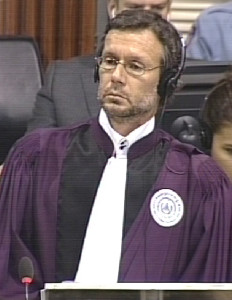
Senior Assistant Prosecutor Vincent de Wilde
Mr. de Wilde resumed his line of questioning. He asked whether there were any Vietnamese interpreters who could translate when they were interrogating the arrestees. He said that each of the places did not have an interpreter. Not all vessels went outside. Mr. de Wilde asked whether it was not obvious then that the Vietnamese people could not answer their questions when arrested. The witness said that the task of questioning was from the division level. Mr. de Wilde asked why he used the word “I” and “we” when relating to arrests while saying that he did not arrest anyone in the two years. He replied that he said “we” when talking about soldiers in general. Mr. de Wilde asked how he learned that refugees had been released if he was not involved himself. He said that this was based on the information he received from the radio broadcast.
Mr. de Wilde asked whether there were any Vietnamese who pretended to be deaf and dumb. The witness replied that he was not aware of this, since his responsibility was different. His main responsibility to maintain the vessel to ensure it functioned properly in case of combat.
In his Written Record of Interview he had said that people pretended to be mad and that they did not believe this.[8] He said that he received this information from the division level, but not what he did. He said that he did not go to Koh She or Koh Thmey. His task was to crosscheck the numbers of vessels. Mr.de Wilde asked whether he worked at night and whether there were more arrests at night or during day time. He said that he went on his mission during night time once a week. He said that he thought the Vietnamese were well aware of what would happen when they would encounter the military ships.
He had talked about arrests.[9] The witness insisted that he received the information second-hand. He received some information from the island, and it was not his responsibility. Mr. de Wilde said that he had indicated in his Written Record of Interview that he witnessed two arrests by his own eyes. The witness replied that he saw the Vietnamese when he arrived on the island, but did not witness the arrest itself. There were four or five of them. He recounted that he “parked his vessels there” and left the area afterward.
Mr. de Wilde turned to the number of Vietnamese that he estimated to have been arrested. He had said that there were more than 100 Vietnamese who were arrested.[10] Mr. de Wilde asked to which period this referred to. The witness said that the statement that Mr. de Wilde had quoted was information that he had heard.
Witness 2-TCW-823, who had been leading troops on Koh Thmey, talked about the arrests and sinking of boats at sea.[11]
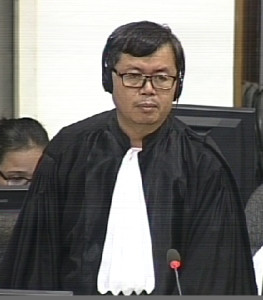
National Khieu Samphan Defense Counsel Kong Sam Onn
National Khieu Samphan Defense Counsel Kong Sam Onninterjected and said that there had been a translation error with regards to the translation of “we” and “I”.
Mr. de Wilde asked whether it was the marine that was in charge of capturing boats at sea or on the islands. He replied that there were two categories of vessels. One group that was the patrol boats stationed on island, whose duties was to capture any boat entering the territory. His vessel was larger and could not be used for that purpose.
He asked what the horsepower was of his boat, which the witness could not recall. There were five machines and one generator.
The President interrupted the questioning and said that the Co-Prosecution had used their time already. He did not allow the Civil Party Lead Co-Lawyers to ask questions.
Judge Jean Marc Lavergne then started putting some questions to the witness. He inquired what he meant when referring to a “hot battlefield”. He answered that in this context that in early 1975, maybe in April there was a fighting between Vietnam and Cambodia. Vietnam captured 720 Democratic Kampuchea soldiers, detained them at Koh Tral. As a result of negotiations, these 720 soldiers were liberated.
The arrests took place on Koh Poulo Wai Cha and Koh Poulo Wai Thmey, which was Cambodian territory according to the witness. He clarified that the Democratic Kampuchea forces went to Koh Tral but were not allowed to enter, so they returned. He did not know the names of these islands in Vietnamese. In 1975, there were no Vietnamese civilians living on those islands. Judge Lavergne asked whether he understood correctly that he said that the Vietnamese forces attacked the Cambodian side, which he confirmed. They attacked the islands to cut off logistics and food supply. The Vietnamese then arrested those Democratic Kampuchea troops.
The attack “was instigated by the other party through their troops and vessels.” He only heard about this and was not present.
Juddge Lavergne then asked whether he was present when the Mayaguez was captured, which he denied. “At that time, I did not have any vessel under my supervision, and I was stationed on shore.”
Deportations of Vietnamese
Judge Lavergne turned to the next topic and asked who had decided that the deportation of Vietnamese would be carried out and how many people were deported in 1973. He answered that there was a clash of the Viet Cong force and the Democratic Kampuchea force in Kampot. Those Viet Cong forces took refuge in the territory of Cambodia and clashed with the Democratic Kampuchea forces. Ta Mok had ordered their presence. Later on, it was said that they should not engage in conflict with those forces. The commander in charge of the Southwest Zone was Ta Mok at the time. The relationship between Ta Mok and the Vietnamese troops were not clear to him at the time. His unit engaged in combat with the Vietnamese troops. Ta Mok met with a military commander on the Vietnamese side, whose name is Bay Soeun. Later, there was another representative who led the negotiations for the Vietnamese troops to be allowed to stay at a mountain.
Judge Lavergne asked whether there was an evacuation of Vietnamese civilians in 1973, or whether some Viet Cong had to leave the country. He answered that he referred to the Viet Cong who took refuge in Cambodia. The clash lasted for more than a fortnight, after which Ta Mok arrived. He ordered to stop the fighting. He could not recall the date that they disappeared from Democratic Kampuchean territory.
Judge Lavergne asked what he could tell about the two later deportations. Mr. Sarat said that he did not know how many civilians or soldiers there were. Judge Lavergne then wanted to know how he knew about these deportations. He answered that he was not personally involved in this matter.
Judge Lavergne asked whether he heard about a program in which people of Vietnamese ethnicity were exchanged to Khmer people from Kampong Som, which he denied. Judge Lavergne wanted to know whether he people who were stationed on the island were deported. He answered that he was initially stationed near an airfield, after which he was stationed at Koh Kahrong Sahlong. He only saw Cambodians and not Vietnamese there. Even the Cambodian fishermen returned to Kampong Som and did not stay at the island. He did not know whether there were any Vietnamese people living at a specific location.
Instructions by the division level
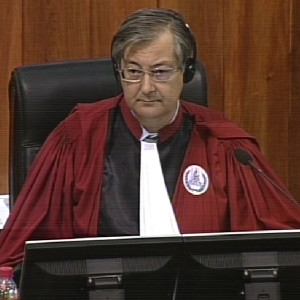
Judge Jean-Marc Lavergne
After the lunch break, the President informed Mr. Prum Sarat that there was no duty counsel available now. The witness agreed to continue testifying. Judge Lavergne then resumed his questioning. He asked whether Koh Tral and Koh Krachhes Sres another island were part of the “hot battlefield”, which the witness confirmed. He himself had never been there. He had looked at a map and seen that they were within Cambodian territorial waters. The map he used for his training was a map that was produced in 1949. Judge Lavergne then wanted to know whether he was told in his training that these islands belonged to Cambodia or Vietnam. He answered that the trainer did not mention which islands belonged to which country. He received the task from the division level to patrol near Koh Krachhes Sres and Koh Thmey, not Koh Tral. He did not hear that soldiers were captured at Koh Tral. They were instead captured at Koh Poulo Wai and Koh Poulo Wai Thmey and brought to Koh Tral.
His responsibility was not the same as those people who arrested people. Judge Lavergne asked how he was aware of orders given from the division level if he himself did not receive any. He said that the upper level gave orders to the division, which informed soldiers about the specific situations and that they needed to be vigilant and ready to fight. As for the information how refugees were to be treated, he said that it was common practice that he used at the time regarding the order that he received from the division.
Judge Lavergne asked whether he received instructions from the district, which he confirmed. Judge Lavergne asked whether this did not contradict the statement he had made before. The witness said that he did receive instructions. When Judge Lavergne asked what kind of instructions these were, he said that he received orders to be vigilant. “The instruction that I received was to an extent that the soldiers who were on the vessel needed to perform their assigned task and they had to be ready to attack the enemy who trespassed [the border]”.
Judge Lavergne referred to minutes from a meeting from the Standing Committee.[12] The witness replied that the attacks and counterattacks on Koh Tral “happened on many occasions.”
The witness recounted that he received guidelines and orders during training sessions about arrests of Vietnamese. This had “something to do with techniques and strategies.” At the time, he received such instructions to comply with. For example, he had to report to the upper level when a machine did not work. “There was a clear reporting system. We needed to send the report to the division, after which there was a decision [issued] to me.” Judge Lavergne said that he had referred to precise instructions to send all members of a crew. The witness replied that he, in accordance with the implementation of technical skills, received no orders on the issue of sending crew members and equipment. “I myself was doing my utmost to re-fashion myself.”
Judge Lavergne then referred to the meeting of secretaries and deputy secretaries, the minutes of which were available to the Court.
The witness did not shed light on a number of questions Judge Lavergne put to him.
After Judge Lavergne had read out another extract, he remembered that there were guidelines to “ensure the victory”.
Judge Lavergne turned to the next topic and asked whether he was charged with collecting biographies of his subordinates. Mr. Sarat replied that the biography was to be collected so that all combatants had to give their biographies. The purpose to collect the biography of a soldier was to see the following:
- The soldier was engaged on the battlefield on a frequent basis andthey had the competency to attack the enemy
- The origin of that person: were they former monks, students, or what was their origin?
The biography was then sent to the upper level. It was his understanding that there was a movement in the East led by Sao Phim. It was his understanding that the biographies were collected to find out who was linked to Sao Phim. Judge Lavergne asked whether this meant that if someone indicated that he was from the East Zone, had a bad biography. He replied that there were other qualifications, such as whether they were competent in combat. To his recollection, the army was divided into two. He was tasked to take charge of a vessel.
It was not up to their discretion to send someone to the headquarter. When an individual was removed from his respective unit, it was the responsibility of the division where to send him to.
Judge Lavergne then inquired whether he ever met someone called Nat. He answered that he attended a study session in the Olympic Stadium, where he saw Ta Nat. Ta Nat had replaced Son Sen. He did not know whether there was a link between S-21 and Ta Nat. Judge Lavergne then wanted to know whether he ever met Duch, which the witness denied. However, he had heard his name. He said that he had heard his name when the Trial Chamber was trying Case 001.
At this point, the hearing was adjourned for a break.
Training sessions
After the last break of the day, the floor was given to the Khieu Samphan Defense Counsel.
The witness said that his training should have been in around August (in E319/23.3.54). She asked whether it was correct that his first training lasted for six months, which he confirmed. She then inquired whether it was in late 1976 that he took charge of a boat. He answered that he was not yet appointed captain of the ship in late 1976. The chief of the boat that he was stationed at in the beginning, Horn, had passed away by now.
During the meeting of the standing committee, there was some disagreement.
Ms. Guissé wanted to know whether he was never the secretary or deputy secretary of a division, referring to minutes of a meeting of secretaries and deputy secretaries (E3/13). He said that he was the secretary of a company. He agreed that the battalion was higher than a company. Thus, the commander of a battalion was also superior to the one of a company.
She asked whether he knew of training sessions that were only for battalion commanders and above, so whether he knew of trainings that he could not attend because of his rank.[13] He said that there were meetings and he was invited to attend sometimes. Khieu Samphan wanted to know whether he ever received instructions to kill Vietnamese civilians, including babies. He answered that to his recollection, he was “pretty sure” that at the time there were no such principles. He did not receive any instructions to kill Vietnamese civilians or infants during those meetings.
He had mentioned in his interview that he went to Phnom Penh.[14] He answered that he remembered attending two study sessions in Phnom Penh. In the first one Son Sen was the instructor. The second session took place in 1977. She then inquired whether he knew of any members of his crew who were sent to be re-fashioned, which he denied.
He said that all technical cadres had to engage in the training of the vessels.
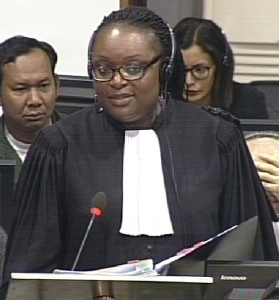
International Khieu Samphan Defense Counsel Anta Guissé
Ms. Guissé asked whether the port Ream was accessible to ordinary boats. He replied that there was an old military port at Ream from the Lon Nol regime. It was used prior to 1975 and it was used for the military. Ms. Guissé asked whether it was correct that he obtained information through the radio, which he confirmed. They used radio communication between the ships and headquarters. She asked whether he remembered to ever have been coming aware of a capture of Vietnamese weapons on a boat. The witness asked her to provide sources. He said that he did not hear such information.
A witness had spoken about gunfire.[15] She said that also 2-TCW-1000 spoke about fire exchange. He replied that there were clashes at sea. His vessel was not engaged in such clashes, however. He could not provide details, he said, on small fire exchanges.
She sought further details about administrative structures.[16] He said that he did not know it worked in the cooperatives, since he was with the army.
The President thanked the witness and dismissed him. He instructed the court officer to usher the new witness in.
New Witness: In Yoeun
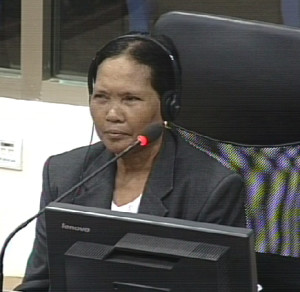
Witness In Yoeun
In Yoeun, 65, was born in Tradak Cheu Phleung Village, Kampong Trach Commune, Romeas Hek District, Svay Rieng Province, where she also currently resides. The President then informed the witness about her rights and obligations. The floor was then given to the Co-Prosecutors.
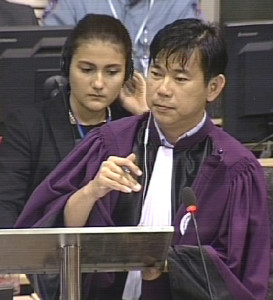
National Deputy Co-Prosecutor Srea Rattanak
National Deputy Co-Prosecutor Srea Rattanak asked what her husband’s name was. She said it was Chan Tea. She was transferred from her birth village to another Trakeab Kdam Village. Trakeab Kdam Village is also in Kampong Trach Commune. In 1975 until 1979, she lived in a mobile unit and was separated from her parents. Her mobile unit was sent to Roh Prohsot in Chan Trea district. She was assigned to dig embankments there. She was relocated to Kampong Trat. She spent a long time there before being relocated in 1975, because “there was collective marriage organized for us at the time.” After the collective marriage, they were relocated to the West. She could not recall where this was.
The President adjourned the hearing. It will continue tomorrow morning at 9 am. 2-TCW-1007 will be on the reserve.
[1] p. 101, 0097425354 (EN), 00926431-32 (KH).
[2] E3/847
[3] E319/23.3.44.
[4] Answers 31 to 33.
[5] E1/69.1.
[6] E319/23.3.44 answer 25
[7] Answer 29.
[8] Written Record of Interview of Prum Sarat, p. 53.
[9] Answer 121.
[10] Answer 132.
[11] E319/23.3.21, answer 124.
[12] E3/227.
[13] E3/13, p. 1.
[14] E319/23.3.54, answer 78.
[15] E319/23.3.21.
[16] E3/9113, at 00974249 (EN), 00926425 (KH).
